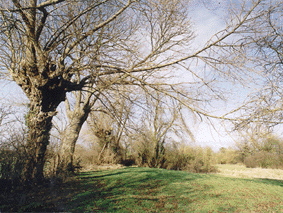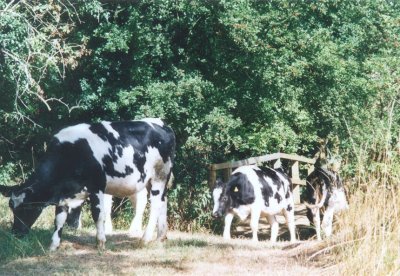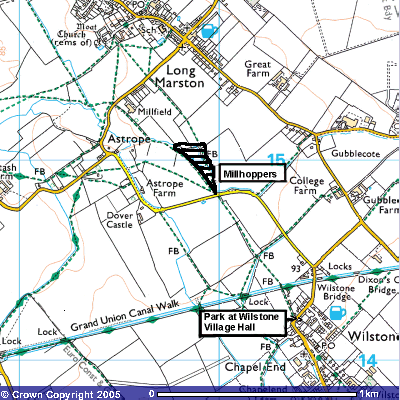This tranquil reserve is approx 3 acres (1.2 hectares) in size and consists of unimproved grassland surrounded by a variety of large trees and hedgerow. The site was acquired by the efforts of a few individuals from the adjacent village of Long Marston, a grant from Dacorum Borough Council and Butterfly Conservation. It was finally secured by Butterfly Conservation and dedicated to Gordon Beningfield in 1998 who sadly passed away just before the opening.
Habitat management is vital to create and maintain a varied habitat in order to enhance the Lepidoptera (butterfly and
moth) species on the reserve and promote other wildlife. To make this possible volunteers are needed for the monthly work parties.
Work parties (WPs) are now held every month on the first Sunday of the month both winter and summer and started in August 2017.
The WPs start at 9:50 am and finish around 2.30 pm (with a break for lunch) - Parking by the reserve is limited and so it is
suggested that volunteers park in Wilstone Village and walk across the fields (see directions below).
If you would like to volunteer at any time and would like more information please contact:
Paula Reid
As well as the usual management strategies of keeping the scrub in check and mowing and raking a proportion of the sward in autumn and spring to lessen the fertility and to encourage the growth of more wildflowers, the wardens have worked hard to increase the biodiversity at Millhoppers Nature Reserve by constructing a lined pond and a chalk bank.
The pond was dug in the autumn of 2021, after warden Chris Hilling did some careful research on the best shape/depth etc. for a wildlife pond. The result was a pond with one deep section and very shallow, wide edges. Some pebbles have been put around the edge of the pond in places, to give a more natural look and increase the pond habitat, and native pond plants have been introduced, including some Marsh Marigold plants which used to grow so well at Millhoppers when the site was wetter. The pond has been buzzing with activity since early spring and has attracted numerous species, including damselfly and dragonfly, frogs, hoverflies and many types of bugs and beetles. Now that the stream at Millhoppers only flows in the winter months, it seems right to have a water body on the site all year round, to provide a place for insects and amphibians to breed and all this wildlife makes the pond a great attraction to anyone visiting the site. A fence has been erected around the pond with the help of a group of our own and Chiltern Society volunteers, to make the site safe, and also to keep out the sheep which may well be grazing at Millhoppers in the spring and autumn months in future years. A hibernaculum has been constructed close to the pond to provide sheltered places for amphibians to hibernate.
The chalk bank has been constructed this autumn with the soil which was dug out to make the pond and chalk sourced from local excavation work on the Wendover Arm of the canal. The bank has been seeded with Bird’s-foot Trefoil, Rock Rose and Kidney Vetch which are the food plants of the Common Blue, Brown Argus and Small Blue butterflies respectively, and Common Knapweed and Greater Knapweed have been seeded at the bottom of the bank to provide a good nectar source for pollinators. This bank is important, as generally the soil at Millhoppers is quite fertile and smaller wildflowers tend to be out-competed by course grasses and Hogweed which can dominate. The chalk will be an ideal medium for the more delicate wildflowers which are such a good food source for butterflies and other pollinators, and we are hoping the new Kidney Vetch plants will attract the Small Blue butterfly to the site. The shape of the bank will allow insects to enjoy a sunny, south facing slope, but will provide more shady places when the weather is very hot.
Our wonderful volunteers have been extremely supportive with both of these projects and have given us extra days’ help to move the chalk and to help to construct the fence, so we would like to express our great thanks to all who help us on the reserve.
New volunteers are always welcome. Please contact us for more information.
 |
 |
Grassland management
To maintain the grassland and prevent it being overrun with blackthorn, volunteers have been
using tree-poppers to remove the unwanted saplings and their roots.
To reduce the growth of the more aggressive species within the grassland (e.g. nettles, hogweed
and thistle) and provide a suitable habitat for wildflowers to grow the grassland needs to be cut
mechanically each spring and autumn, or better still grazed with sheep or cattle. In the autumn of
2018, the repairs to the perimeter fence were finally completed and in November 2018 Herdwick
sheep were introduced to graze the reserve for the winter for the first time in recent times.
The encroaching Blackthorn hedge line has been pushed back in various places and some
conservation hedge-laying started over the 2018/2019 winter. These activities will continue
throughout the winter of 2019/2020.
All the hard work of the past 2 years is starting to pay off as we have observed an increase in the
quantity of wild flowers present (cowslip and lady's bedstraw) and also the presence of some new
species (at least since 2017), these include birds-foot trefoil and red campion. In addition, the
percentage of grasses to the more aggressive species has increased a little, where we have
focused our attentions.
Estate Maintenance
The reserve historically contained a marshy area alongside a small stream. For a number of years there has been no year-long water in the stream and a number of water- specific species are no longer present. However, the streambed and marsh area require yearly cutting. The wardens are still working with various organisations in order to re-establish regular water flow through the reserve. This will reinstate the stream and marshy area and provide additional habitat to increase the wildlife diversity of the reserve.
Butterfly transects were completed each summer at Millhoppers and the species recorded
Small Skipper |
Orange Tip |
Small Tortoiseshell |
Essex Skipper |
Common Blue |
Comma |
Large Skipper |
Holly Blue |
Speckled Wood |
Brimstone |
Small Copper |
Marbled White |
Large White |
Red Admiral |
Meadow Brown |
Small White |
Painted Lady |
Gatekeeper |
Green-veined White |
Peacock |
Ringlet |
Moths recorded at Millhoppers
169 species of moth have previous been recorded at Millhoppers. The new wardens have organised a moth survey on the 21st July 2019.
The strange name possibly originates from a stream-crossing to an old mill long since untraceable. Others contend that it derives from mill-stones laid to enable people to cross the stream. The entire area then was much wetter. Millhoppers is a rare example of a remnant of ancient countryside encircled by arable land. It contains a large section of unimproved grassland. Some of the hedges are thought to date back to Tudor times. It possesses a pond fed by a stream and a public footpath provides access on one side.
The site has a large stand of blackthorn scrub which provides good cover for birds and mammals. There are 16 black poplar trees in the hedgerow. This a nationally rare tree, but not uncommon locally.

|
| The Black Poplars at Millhoppers |
At the beginning, the main efforts were directed to cutting and raking off grass. In addition, the vigorous blackthorn scrub and large banks of nettles had to be contained.
In the summer of 2001, a new bridge was built across the stream. It is a good, secure structure, which can safely carry grass cutting machinery. Cattle were introduced to the reserve in 2003, and it was planned that they would graze both in the autumn and the spring. These animals were provided and cared for by a local farmer but unfortunately in 2006 grazing was no longer possible.
This meant that more cutting and raking had to be undertaken, whilst new animals were found to graze the reserve.
In 2007, an 'Awards for All' grant was obtained, and a new Reserve interpretation board was designed and leaflets printed At the beginning our main efforts were directed to cutting and raking off grass. In addition the vigorous blackthorn scrub and large banks of nettles have to be contained.
In 2009, John Noakes stood down as the first Reserve Manager, and Jez Perkins took over. We are most grateful to them both for their dedication and hard work in managing Millhoppers since the Branch acquired it.

|
| The cows crossing the bridge soon after they arrived in 2003 © photo: John & Margaret Noakes |
Unfortunately there is limited parking space by the reserve and it is suggested that if visiting, you park in Wilstone Village and walk across the fields.
When walking from Wilstone, follow the public footpath alongside the children's playground next to the Village Hall. Cross the canal via the footbridge and head across the fields towards Long Marston. Go straight on without turning left or right until you reach Watery Lane (aka Astrope Lane). Across the road there is a choice of 3 footpaths - the right-hand one leads immediately to the reserve entrance, which is through a metal gate on the left. Total distance: half a mile. (Grid reference for Village Hall is SP903142
[Landranger Map 165] or postcode HP23 4PE).
For more detail click on map >> >>

Public transport
Wilstone is served by local buses.
Site access and Safety
Access is via footpath gates and stiles. Path bridges cross the stream and these may be slippery in the wet. The Public Footpaths run along the edges of the reserve, and access onto it is on a permissive basis.
When cattle and sheep graze the site, dogs must be kept on leads.
Please clean up after your dog.
Most ticks are little more than an irritation, but a few can transmit Lyme disease, a rare and potentially serious illness which is treatable with antibiotics if diagnosed early. It is therefore important to be informed and take some simple precautions.